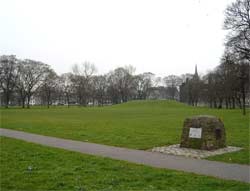WordPress database error: [Got error 28 from storage engine]
SELECT t.*, tt.*, tr.object_id FROM wp_terms AS t INNER JOIN wp_term_taxonomy AS tt ON tt.term_id = t.term_id INNER JOIN wp_term_relationships AS tr ON tr.term_taxonomy_id = tt.term_taxonomy_id WHERE tt.taxonomy IN ('category', 'post_tag', 'post_format') AND tr.object_id IN (4540, 5706) ORDER BY t.name ASC
The Siege of Leith
Living in Edinburgh you are always aware that wherever you go you are trekking over centuries of history, that you can’t walk anywhere without walking on ancient bones. However in our little office in Leith we were completely unaware of the history right under our feet.
King James V died in 1542 when the heir to the throne Mary (Queen of Scots) was only six days old. His Queen Consort, Mary of Guise ruled as Regent until such time as Mary was able to take up the throne. Mary was French with strong family connections so the bond between Scotland and France, the ‘auld alliance’ was stronger than ever.
This did not please the English and the Protestant movement in Scotland which had been gathering momentum for some time. As the situation worsened Mary called for support from her home nation. France responded and 3000 troops arrived in Leith and set up a garrison there.
English troops, assisted by the Protestant Scottish factions had been camped around the entrance to the River Forth and the French (crack troops fresh from European wars) set about routing them. The French were commanded by Monsieur D’Essé, he quickly realised the strategic importance of Leith and set about building massive fortifications around the town. The French mounted a successful assault on the island of Inchkeith, killing the garrison commander, and returning in triumph. The Scots had mounted batteries around the Leith fortifications and once again the skilled French broke out to attack them. They easily captured cannons mounted on Calton Hill. Fighting raged across Leith links and up onto the higher ground by Hawkhill and Prospect Hill. The protestant Scots began to feel that their God had deserted them. A more convenient excuse rather than the reality that their relatively inexperienced and ill disciplined army were no match for the French.
Gradually though the English and Scottish alliance began to gain the upper hand. English warships blockaded the port and stopped supplies from reaching the French garrison. Fortified batteries and siege trenches grew nearer to the French positions. Three massive batteries were set up surrounding them; Mount Falcon (near Leith hospital) Mount Pelham and Mount Somerset (situated on high ground to the south of the current Leith links). The constant bombardment wore down the French and the terrified Leithers still living in the town. Despite several successful French raids they were beginning to starve, reduced to eating horsemeat the end was in sight (an excavation in recent times at the bottom of Easter road discovered an old well full of horses heads).
Nevertheless the French had been given orders to defend the town to the last man and no amount of force was going to remove them. The English, tired of the conflict and of the constant jibes from the French ramparts looked for a different route to victory and looked towards their diplomats to settle the issue.
Mary of Guise had fallen gravely ill by this time and Queen Elizabeth’s secretary, Sir William Cecil arrived in Leith to negotiate a truce. The Treaty of Edinburgh was drawn up and the French were offered safe passage home with the English also returning south. On the 16h July 1560, the French troops marched out of Leith after sacking it and so twelve years of French involvement in Scotland came to an end.
However the story was not over yet. Mary, Queen of Scots who had become Regent on the death of her mother refused to accept the treaty; this was down to one condition, that she ceased using the coat of arms of England. This may seem a minor point but with her marriage to Lord Darnley, who was grandson to Margaret Tudor Mary’s claim to the English throne had become stronger – coupled with the Catholic belief that Elizabeth was illegitimate this made Mary the true heir. Elizabeth never forgave her cousin for this and it became one of the reasons for her execution.
The siege of Leith has to a certain extent been forgotten and regarded as just another incident in an eventful and bloody period of Scottish history however it has great significance. For one thing it was the first time that Scotland and England fought side by side. It could also be considered as the last significant foreign occupation of the British mainland and marked and end to both the alliance with France and the catholic domination of Scotland.
Related Blogs to Leith

The Gallow Lee; The Monsters in the Mortar!
Read More

Clan Douglas and The Battle of Ancrum Moor
Read More







